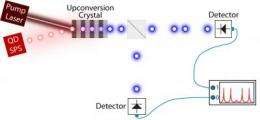This little light of mine: Changing the color of single photons emitted by quantum dots

Researchers at the National Institute of Standards and Technology have demonstrated* for the first time the conversion of near-infrared 1,300 nm wavelength single photons emitted from a true quantum source, a semiconductor quantum dot, to a near-visible wavelength of 710 nm. The ability to change the color of single photons may aid in the development of hybrid quantum systems for applications in quantum communication, computation and metrology.
Two important resources for quantum information processing are the transmission of data encoded in the quantum state of a photon and its storage in long-lived internal states of systems like trapped atoms, ions or solid-state ensembles. Ideally, one envisions devices that are good at both generating and storing photons. However, this is challenging in practice because while typical quantum memories are suited to absorbing and storing near-visible photons, transmission is best accomplished at near-infrared wavelengths where information loss in telecommunications optical fibers is low.
To satisfy these two conflicting requirements, the NIST team combined a fiber-coupled single photon source with a frequency up-conversion single photon detector. Both developed at NIST, the frequency up-conversion detector uses a strong pump laser and a special non-linear crystal to convert long wavelength (low frequency) photons into short wavelength (high frequency) photons with high efficiency and sensitivity (See www.physorg.com/news170516085.html).
According to Matthew Rakher and Kartik Srinivasan, two authors of the paper, previous up-conversion experiments looked at the color conversion of highly attenuated laser beams that contained less than one photon on average. However, these light sources still exhibited "classical" photon statistics exactly like that of an unattenuated laser, meaning that the photons are organized in such as way that at most times there are no photons while at other times there are more than one. Secure quantum communications relies upon the use of single photons.
"The quantum dot can act as a true single photon source," says Srinivasan. "Each time we excite the dot, it subsequently releases that energy as a single photon. In the past, we had little control over the wavelength of that photon, but now we can generate a single photon of one color on demand, transmit it over long distances with fiber optics, and convert it to another color."
Converting the photon's wavelength also makes it easier to detect, say co-authors Lijun Ma and Xiao Tang. While commercially available single photon detectors in the near-infrared suffer noise problems, detectors in the near-visible are a comparatively mature and high-performance technology. The paper describes how the wavelength conversion of the photons improved their detection sensitivity by a factor of 25 with respect to what was achieved prior to conversion.
More information: *M. T. Rakher, L. Ma, O. Slattery, X. Tang, and K. Srinivasan. Quantum transduction of telecommunications band single photons from a quantum dot by frequency upconversion. Nature Photonics. Published online Oct. 3, 2010, doi:10.1038/nphoton.2010.221
Provided by National Institute of Standards and Technology



















